Situated in the southeastern area of the United States, the state of Alabama is known for having a rich and diverse ecosystem, with mountain valleys, rivers, forests, and a coastal plain. These habitats all provide the perfect place for animals to thrive, as is evident by the number of snakes in the state. There are 43 different species and six of these are venomous, with varying levels of danger. Although some snakes are bright and full of color — such as the milk snake — others are much more difficult to spot as they are camouflaged by their color. Let’s take a look at the brown snakes in Alabama that you might encounter, and learn where they live and what they look like.
1. Prairie Kingsnake (Lampropeltis calligaster)

The prairie kingsnake is one of the common brown snakes in Alabama and it is nonvenomous.
©Matt Jeppson/Shutterstock.com
The first snake on our list is the prairie kingsnake, which is also called the yellow-bellied kingsnake. Prairie kingsnakes are 30 to 40 inches long with a light brown-to-tan body and darker spots. Their belly is light grey or white but has dark-colored markings on them. Prairie kingsnakes inhabit grasslands and pine flatwoods in the northern region of the state. There are also some populations scattered around the Tennessee River. Prairie kingsnakes are fairly placid snakes and rarely ever bite even when threatened. They are not venomous but can mimic a rattlesnake by moving their tail around in the leaves.
2. Diamond-Backed Water Snake (Nerodia rhombifer)
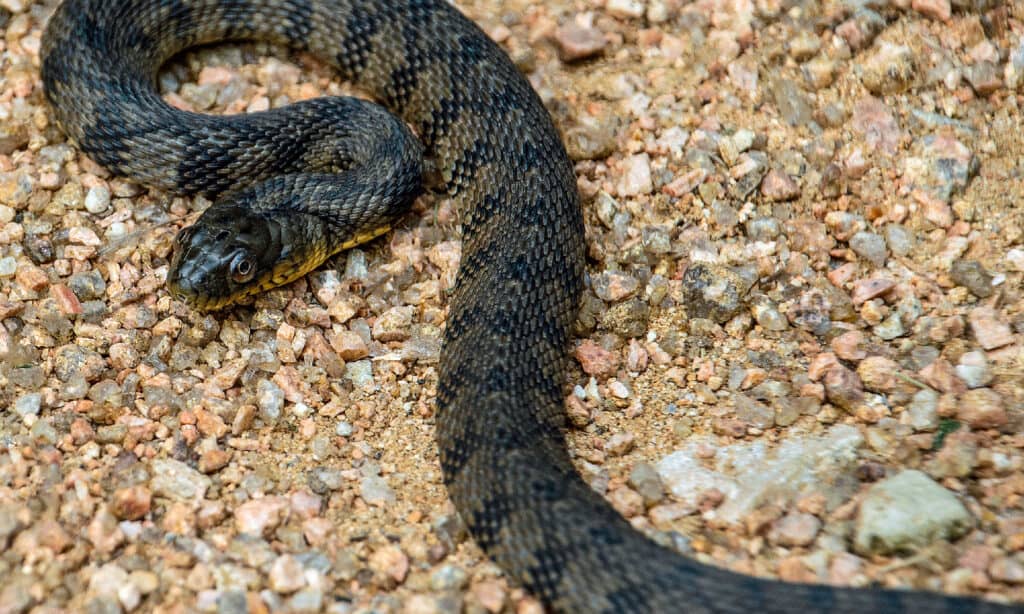
The diamond-backed water snake is one of the brown snakes in Alabama that lives only in freshwater.
©iStock.com/williamhc
Next up is the diamond-backed water snake, which is the first of several water snakes in the state. Diamond-backed water snakes are typically 30 to 48 inches long, although longer specimens are not uncommon. They have dark, greenish-brown bodies which are overlaid with a series of dark brown markings in the shape of diamonds. Diamond-backed water snakes live in slow-moving bodies of water in the western half of the state — particularly around the Black Warrior and Tombigbee rivers. They are often active during the daytime hours and prey on a variety of fish and frogs. Although they are not venomous and prefer to flee in the face of adversity, they are highly aggressive if they are trapped and will bite repeatedly.
3. Eastern Copperhead (Agkistrodon contortrix)

Common brown snakes in Alabama include the eastern copperhead, which is a venomous snake.
©iStock.com/David Kenny
The eastern copperhead is the first of four venomous snakes on our list. Unfortunately, eastern copperheads are one of the most frequently encountered venomous snakes in the state and live in woodlands, forests, swamp edges, and hillsides. They are 24 to 36 inches long and have pinkish-tan bodies with reddish-brown hourglass-shaped crossbands. Copperheads prey on a wide range of mammals, birds, and amphibians. Fortunately, they have fairly weak venom and are not naturally aggressive snakes. However, any bite from them should still be treated as serious.
4. Southeastern Crowned Snake (Tantilla coronata)

Southeastern crown snakes are brown snakes in Alabama that are not aggressive toward humans.
©John Sullivan / CC BY-SA 3.0 – License
A particularly small snake in Alabama is the southeastern crowned snake. These snakes are only eight to 10 inches long. Southeastern crowned snakes have brown bodies but distinctive black heads and necks. They also have a brown ring that separates the black end of their head and neck. Southeastern crowned snakes are shy snakes and prefer dry forests and woodlands with well-drained soil so that they can easily burrow into it. They are still widespread across Alabama but their numbers are thought to be declining. They are not venomous and therefore prey mainly on worms and termites.
5. Brown Water Snake (Nerodia taxispilota)
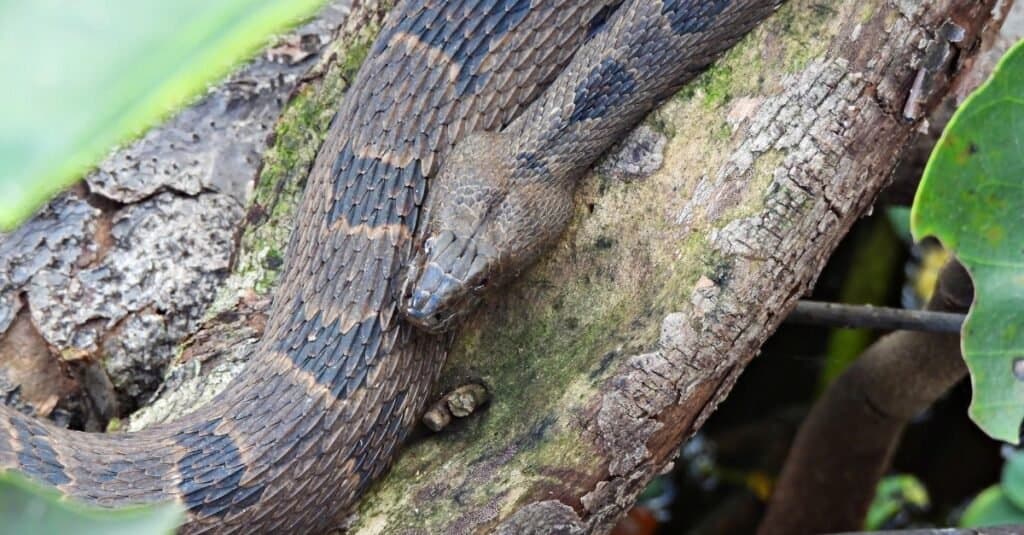
Brown water snakes in Alabama are large, nonvenomous snakes that often get mistaken for copperheads.
©iStock.com/passion4nature
Next, we have the brown water snake which occurs in the southeastern region of the state. They primarily prey on fish and live in slow-moving bodies of water such as rivers, creeks, lakes, and swamps. Brown water snakes are large snakes at 30 to 60 inches long and have brown bodies with dark brown square-shaped spots along their back. They also have smaller spots along their sides and a yellowish belly with brown markings. They are mistaken for cottonmouths, but they are not venomous. Additionally, brown water snakes prefer to flee back into the water if they are approached. However, if they are trapped, then they may bite as a last resort.
6. Timber Rattlesnake (Crotalus horridus)
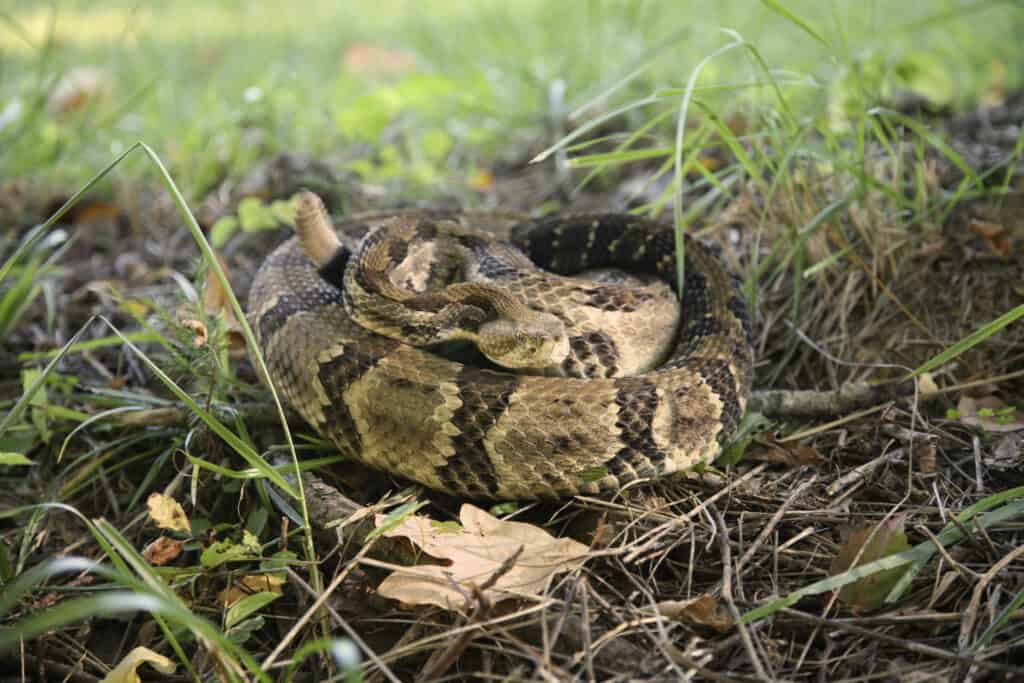
The timber rattlesnakes are extremely venomous brown snakes in Alabama.
©iStock.com/NajaShots
Timber rattlesnakes are the next venomous brown snake in Alabama to worry about. They are three to five feet long with black or dark brown crossbands. However, sometimes they can have a darker ground color with black marks, which make the entire snake appear to be black. Timber rattlesnakes occur statewide. Additionally, they typically live in forests and on rocky hillsides. Although they don’t have a particularly aggressive nature, they are regarded as incredibly dangerous as they have very long fangs and a high venom yield.
7. Queen Snake (Regina septemvittata)
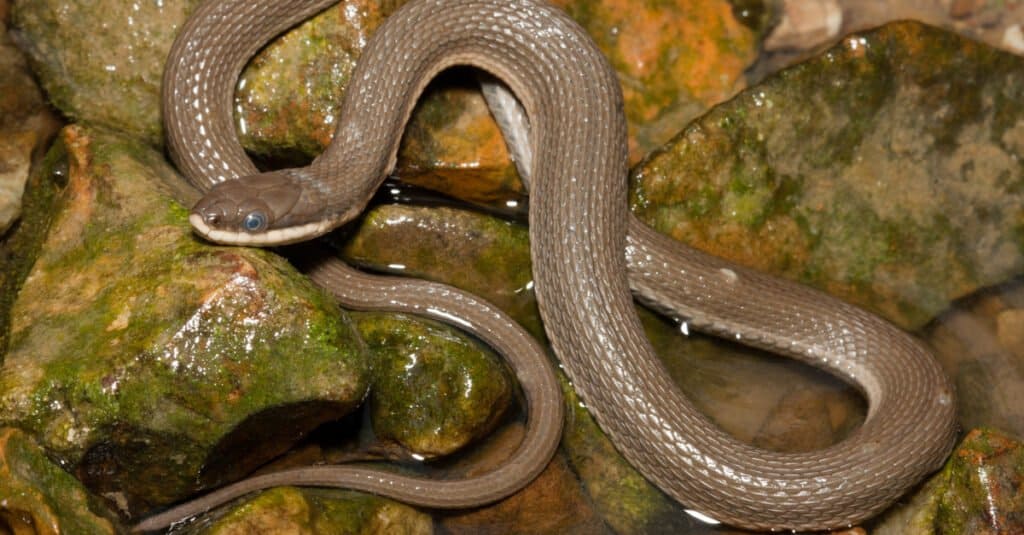
Queen snakes are smaller brown snakes in Alabama.
©Nathan A Shepard/Shutterstock.com
With a flattened head and thickened scales on the top of their head and underneath their chin, queen snakes are uniquely adapted to their habitat. This is because they live in shallow ponds, streams, and rivers and prey on crayfish, which they frequently hunt out between rocks. Queen snakes are typically 14 to 23 inches long and are brown with four darker stripes on their belly. They also have faint stripes on their upper body which are more noticeable when they are young. Queen snakes occur across the majority of the state, with the exception of the coastal plain to the west of the Tombigbee river and the southern region of Baldwin County.
8. Eastern Diamondback Rattlesnake (Crotalus adamanteus)

Eastern diamondback rattlesnakes are one of the largest brown snakes in Alabama and they are venomous.
©Chase D’animulls/Shutterstock.com
The next venomous snake is the eastern diamondback rattlesnake, which is also one of the largest brown snakes in Alabama and the largest rattlesnake species at three to seven feet long. Eastern diamondback rattlesnakes are light brown with up to 35 dark brown diamonds on their body. Progressing further towards the tail the diamondbacks eventually become crossbands. Proportionate to their length, eastern diamondbacks have the longest fangs of any rattlesnake as well as a high venom yield. In addition, eastern diamondbacks occur across the coastal plain in the extreme southern region of the state.
9. Rough Earth Snake (Virginia striatula)
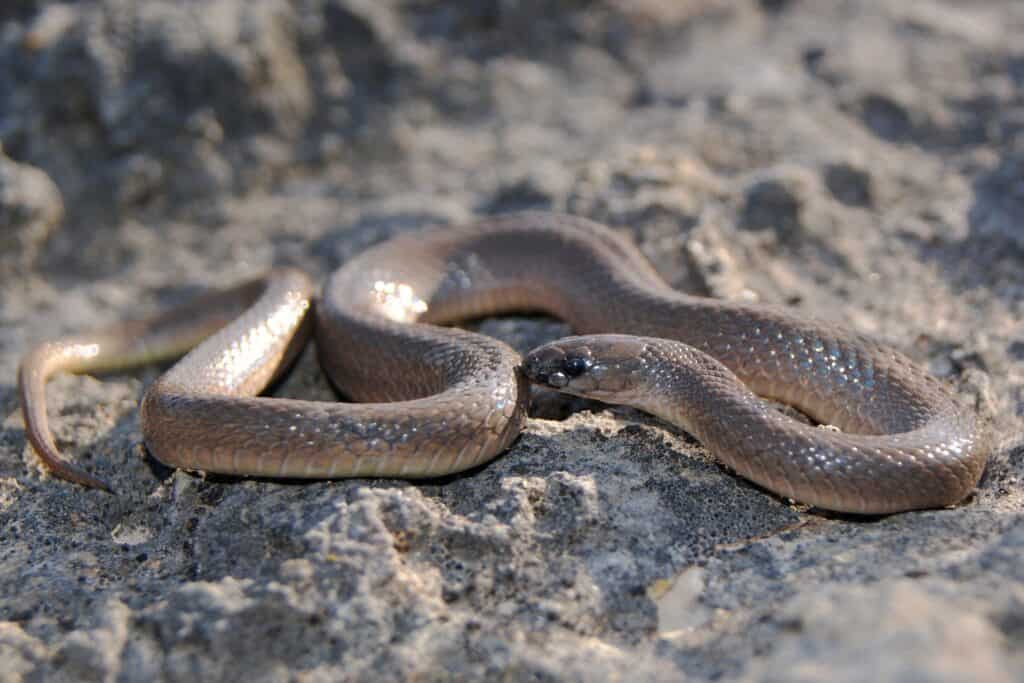
Rough earth snakes are nonvenomous brown snakes in Alabama.
©Matt Jeppson/Shutterstock.com
With the exception of the Interior Plateau, rough earth snakes occur almost statewide in Alabama. Rough earth snakes inhabit forests and are rarely seen as they spend much of their time hiding in the leaf litter or underneath logs and rocks. They are small snakes at only seven to 10 inches long with slender bodies. They are completely brown and lack any distinguishing pattern. Rough earth snakes have keeled dorsal scales which is the main difference between them and smooth earth snakes, which also occur in the state. They prey mainly on slugs and earthworms and are not venomous.
10. Cottonmouth (Agkistrodon piscivorus)
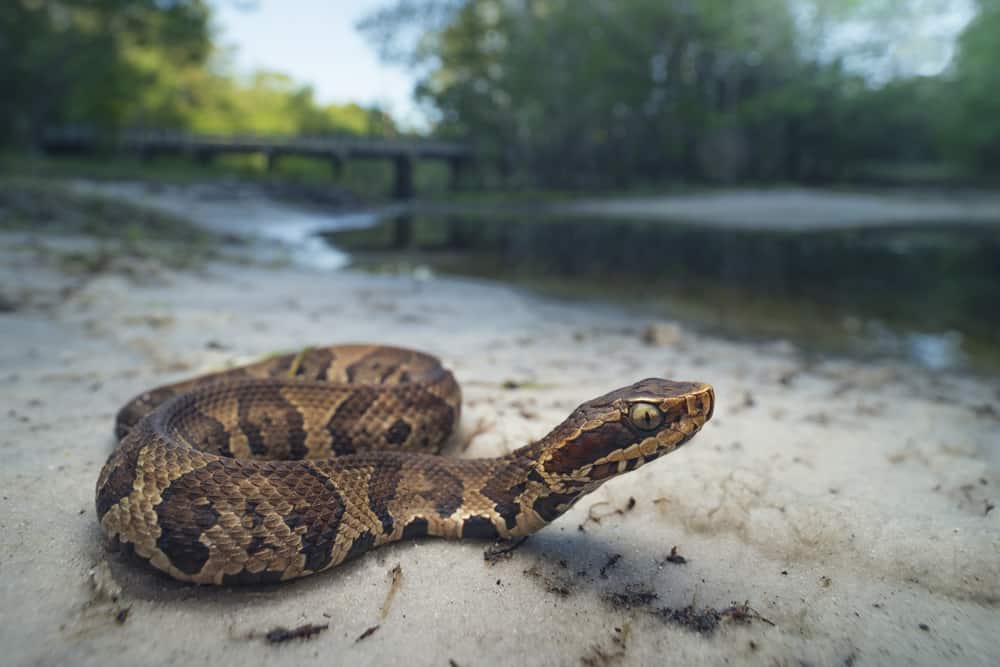
Cottonmouth brown snakes in Alabama are responsible for 1% of fatal snake bites in the United States each year.
©Kristian Bell/Shutterstock.com
We’ve already mentioned several non-venomous water snakes, but now it’s the turn of the venomous cottonmouth, which is the snake they are most often mistaken for. Cottonmouths are semi-aquatic and live in virtually any freshwater habitat across Alabama. They are 30 to 42 inches long and are dark brown with darker brown to black crossband markings. They also have a bright white lining inside their mouth which resembles cotton — hence their name. Cottonmouths prey on a variety of animals both in and out of the water, which are killed by envenomation. Cottonmouths possess cytotoxic venom and account for only around 1% of all fatal snake bites in the US every year. However, their venom is still strong enough to cause serious tissue damage unless antivenom is administered within two hours of the bite occurring.
11. Coachwhip (Masticophis flagellum)
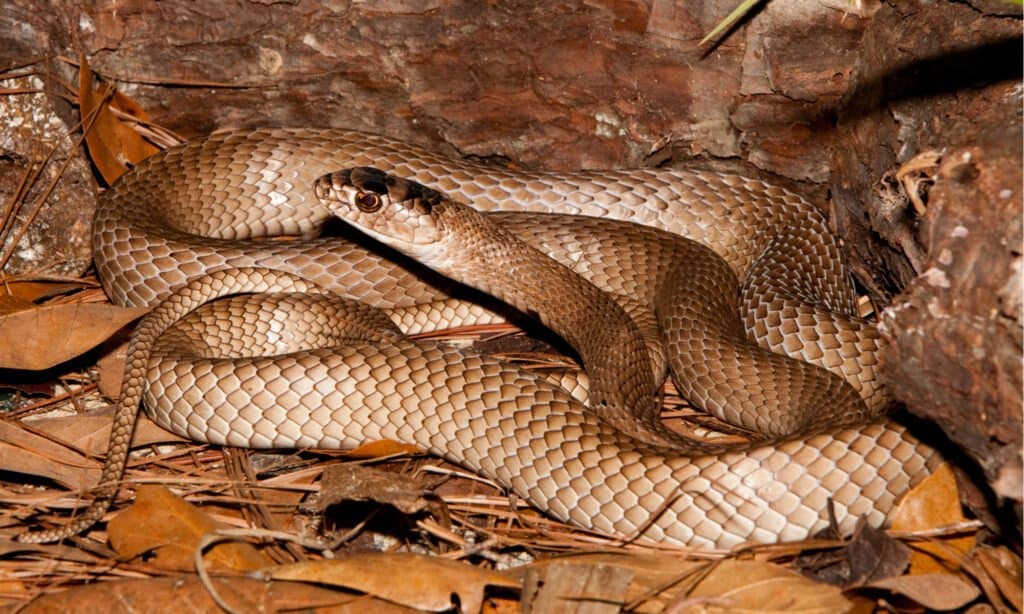
Coachwhips are brown snakes in Alabama that have declining numbers in the northern region.
©Jay Ondreicka/Shutterstock.com
The final brown snake in Alabama we come to is the coachwhip snake, which is named because of the unique appearance that makes it look like a braided coachwhip. Coachwhips are long, slender snakes and can reach around seven feet. They have smooth scales and a black head and neck, which gradually fade to tan at their tail. Coachwhips typically live in dry habitats — such as grasslands, rocky hillsides, scrubland, chaparral, and pine flatwoods. However, although they occur statewide their numbers are declining in the northern region. Coachwhips prey on a wide range of mammals, birds, snakes, and lizards. They are not venomous and swallow their prey alive, using their rows or sharp, inward-pointing teeth to grasp it.
The photo featured at the top of this post is © Creeping Things/Shutterstock.com
Discover the "Monster" Snake 5X Bigger than an Anaconda
Every day A-Z Animals sends out some of the most incredible facts in the world from our free newsletter. Want to discover the 10 most beautiful snakes in the world, a "snake island" where you're never more than 3 feet from danger, or a "monster" snake 5X larger than an anaconda? Then sign up right now and you'll start receiving our daily newsletter absolutely free.
Thank you for reading! Have some feedback for us? Contact the AZ Animals editorial team.






